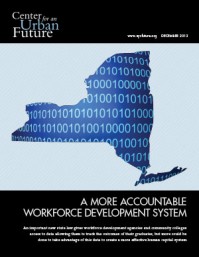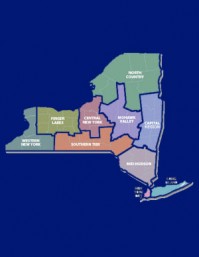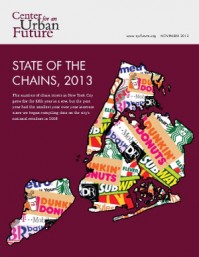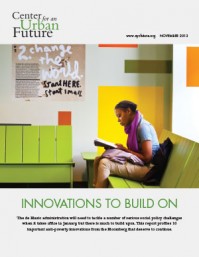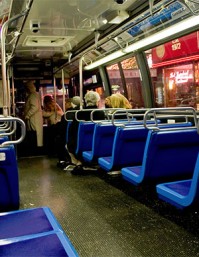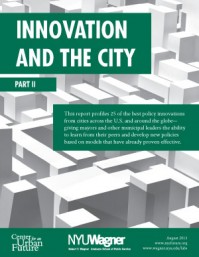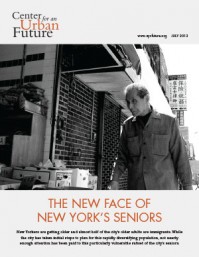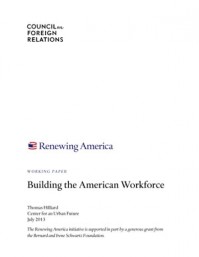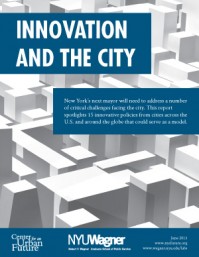Commentary/Op-Ed - January 2014
Op-ed: What Mayor de Blasio can do to increase middle-class jobs, income equalityIn an op-ed for the Daily News, the Center's Jonathan Bowles laments that the pathway to the middle class in New York City is now all but closed off for countless New Yorkers. While acknowledging that the city's soaring cost of living is a problem, he argues that the bigger challenge is that New York's economy seems less and less capable of producing jobs that pay enough to support a middle-class lifestyle in such a high-cost city.
Commentary/Op-Ed - December 2013
A More Accountable Workforce Development SystemAn important new state law gives workforce development agencies and community colleges access to data allowing them to track the outcomes of their graduates, but more could be done to take advantage of this data to create a more effective human capital system.
Data - December 2013
NYS Regional Economic Development Council Awards by Region, 2011-2013NYC has received just 7.8 percent of the state’s Regional Economic Development Council (REDC) grants over the past three years, despite having more than 40 percent of the state’s population and businesses—and being home to the two counties with the highest unemployment rates in the state.
Report - December 2013
State of the Chains, 2013The number of chain stores in New York City grew for the fifth year in a row, but the past year had the smallest year-over-year increase since we began compiling data on the city’s national retailers in 2008.
Report - November 2013
Innovations to Build OnThe de Blasio administration will need to tackle a number of serious social policy challenges when it takes office in January, but there is much to build upon. This report profiles 10 important anti-poverty innovations from the Bloomberg administration that deserve to continue.
Commentary/Op-Ed - October 2013
Op-ed: Next mayor must build a better 311In this New York Daily News op-ed, the Center's Adam Forman writes that while New York created one of the first 311 systems, “the platform for the smartphone era is being created outside of New York.” He suggested that the next mayor should follow the lead of cities like Boston and Chicago, and enhance the 311 system by leveraging the full power of the Internet and mobile computing.
Testimony - September 2013
Testimony: Building Better LibrariesIn this testimony before a City Council hearing, the Center’s Jonathan Bowles points out that while New York’s libraries are more important than ever, the branches’ physical infrastructure hasn't kept pace. And with little capital dollars coming from the city, he argues that library administrators are smart to consider alternative ways of renovating branches.
Commentary/Op-Ed - September 2013
New York Times Room for Debate: Train Workers, Create JobsIn this Room for Debate essay in the New York Times, the Center's Jonathan Bowles argues that with so many New Yorkers out of work, the next mayor will have to make job creation a top priority and take steps to ensure that more New Yorkers are prepared to succeed in the 21st-century economy. The piece was part of a segment called “Vining the NYC Primaries,” in which a handful of New Yorkers were asked to write a brief piece and make an accompanying vine about a key issue facing New York on primary day.
Commentary/Op-Ed - August 2013
New York Times Room for Debate: Think Beyond ManhattanIn this Room for Debate essay in the New York Times, the Center's David Giles writes that to keep up with New York’s dramatically changing economic geography—which has brought about profound changes in commuting patterns—the next mayor will have to focus his transportation efforts beyond Manhattan.
Commentary/Op-Ed - August 2013
Op-ed: Building the American workforceThe U.S. economy faces a big problem that ought to be ripe for a bipartisan solution: too many Americans can’t find jobs, and too many employers can’t find the right person to hire.
Report - August 2013
Innovation and the City, Part IIThis report profiles 25 of the best policy innovations from cities across the U.S. and around the globe—giving mayors and other municipal leaders the ability to learn from their peers and develop new policies based on models that have already proven effective.
Commentary/Op-Ed - July 2013
Innovations in Workforce DevelopmentWith a large number of unemployed residents and a widening skills gap, New York City will need to expand and improve its workforce development system. This policy brief profiles three innovative workforce policies from other cities that could serve as models.
Report - July 2013
The New Face of New York’s SeniorsNew Yorkers are getting older and almost half of the city’s older adults are immigrants. While the city has taken initial steps to plan for this rapidly diversifying population, not nearly enough attention has been paid to this particularly vulnerable subset of the city’s seniors.
Data - July 2013
Data from The New Face of New York’s SeniorsSelected charts and tables from the Center for an Urban Future's 2013 report The New Face of New York's Seniors. The report found that New Yorkers are getting older and almost half of the city’s older adults are immigrants; but while the city has taken initial steps to plan for this rapidly diversifying population, not nearly enough attention has been paid to this particularly vulnerable subset of the city’s seniors.
Commentary/Op-Ed - July 2013
Building the American WorkforceEmployers need more workers with middle skills qualifications, but the supply of applicants with more than a high school diploma and less than a bachelor’s degree doesn't match the demand. In a Council on Foreign Relations report, CUF senior fellow Tom Hilliard argues that policymakers can narrow this gap by overhauling the national workforce development system.
Data - July 2013
More than ManhattanManhattan remains the epicenter of New York City’s economy, but the other four boroughs now comprise roughly 40 percent of all private sector jobs in the city, their highest total ever. In 2012, Manhattan accounted for 60.50 percent of the city’s private sector jobs, down from 65.92 percent in 1982 and 63.08 percent as recently as 2000.
Commentary/Op-Ed - June 2013
Op-ed: New York would benefit by raising graduation ratesIn June 2013, The Buffalo News published an op-ed by our senior fellow Tom Hilliard about the need to increase community college graduation rates in New York.
Commentary/Op-Ed - June 2013
Making New York’s Human Capital System More AccountableGovernor Cuomo ought to sign a new bill that would give workforce development providers and community colleges across the state access to a treasure trove of information to make their programs more accountable and effective.
Report - June 2013
Innovation and the CityNew York’s next mayor will need to address a number of critical challenges facing the city. This report spotlights 15 innovative policies from cities across the U.S. and around the globe that could serve as a model.
Data - June 2013
Still Waiting for NYC’s Biotech BoomNew York City has all the ingredients to become a leading biotech hub, and the Bloomberg administration is pulling out all the stops to support the sector’s growth; but the New York Metro region was only fifth among all regions in biotech VC deals last quarter—and all of the local deals went to companies in New Jersey and Connecticut.


